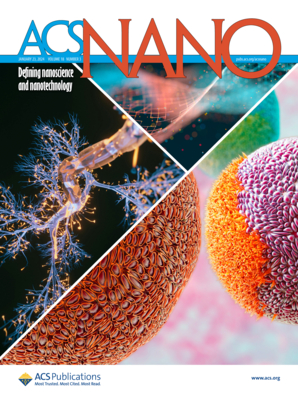Supersaturated Doping-Induced Maximized Metal–Support Interaction for Highly Active and Durable Oxygen Evolution
IF 15.8
1区 材料科学
Q1 CHEMISTRY, MULTIDISCIPLINARY
引用次数: 0
Abstract
Metal–support interaction (MSI) is pivotal and ubiquitously used in the development of next-generation catalysts, offering a pathway to enhance both catalytic activity and stability. However, owing to the lattice mismatch and poor solubility, traditional catalysts often exhibit a metal-on-support heterogeneous structure with limited interfaces and interaction and, consequently, a compromised enhancement of properties. Herein, we report a universal and tunable method for supersaturated doping of transition-metal carbides via strongly nonequilibrium carbothermal shock synthesis, characterized by rapid heating and swift quenching. Our results enable ∼20 at. % Ni2FeCo doping in Mo2C, significantly surpassing the thermodynamic equilibrium limit of <3 at. %. The supersaturation ensures more catalytically active NiFeCo doping and sufficient interaction with Mo2C, resulting in the maximized MSI (Max-MSI) effect. The Max-MSI enables outstanding activity and particularly stability in alkaline oxygen evolution reaction, showing an overpotential of 284 mV at 100 mA cm–2 and stable for 700 h, while individual Ni2FeCo and Mo2C only last less than 70 and 10 h (completely dissolved), respectively. In particular, the SD-Mo2C catalyst also exhibits excellent durability at 100 mA cm–2 for up to 400 h in 7 M KOH. Such a significantly improved stability is attributed to the supersaturated doping that led to each Mo atom strongly binding with adjacent heteroatoms, thus elevating the dissolution potential and corrosion resistance of Mo2C at a high current density. Additionally, the highly dispersed NiFeCo also facilitates the formation of dense oxyhydroxide coating during reconstruction, further protecting the integrated catalysts for durable operation. Furthermore, the synthesis has been successfully scaled up to fabricate large (16 cm2) electrodes and is adaptable to nickel foam substrates, indicating promising industrial applications. Our strategy allows the general and versatile production of various highly doped transition-metal carbides, such as Ni2FeCo-doped TiC, NbC, and W2C, thus unlocking the potential of maximized or adjustable MSI for diverse catalytic applications.

过饱和掺杂诱导最大化的金属与支撑物相互作用,实现高活性和持久性氧进化
金属-基体相互作用(MSI)是开发新一代催化剂的关键和常用方法,为提高催化活性和稳定性提供了途径。然而,由于晶格不匹配和溶解性差,传统催化剂通常表现为界面和相互作用有限的金属-支撑异质结构,从而影响了催化剂性能的提高。在此,我们报告了一种通过强非平衡态碳热冲击合成实现过渡金属碳化物过饱和掺杂的通用且可调的方法,其特点是快速加热和迅速淬火。我们的研究结果使 Mo2C 中的 Ni2FeCo 掺杂量达到了 ∼20 at.%.过饱和度确保了掺入更多具有催化活性的镍铁钴且与 Mo2C 充分相互作用,从而产生了最大化 MSI(Max-MSI)效应。Max-MSI 在碱性氧进化反应中具有出色的活性和稳定性,在 100 mA cm-2 的条件下,过电位为 284 mV,可稳定工作 700 小时,而单个的 Ni2FeCo 和 Mo2C 只能分别工作不到 70 小时和 10 小时(完全溶解)。特别是,SD-Mo2C 催化剂在 7 M KOH 溶液中,100 mA cm-2 下的耐久性也达到了 400 小时。稳定性的大幅提高归功于过饱和掺杂导致每个钼原子与相邻杂原子紧密结合,从而提高了 Mo2C 在高电流密度下的溶解电位和耐腐蚀性。此外,高度分散的 NiFeCo 还有利于在重构过程中形成致密的氢氧化物涂层,进一步保护集成催化剂的持久运行。此外,该合成方法已成功扩大到制造大型(16 平方厘米)电极的规模,并可适用于泡沫镍基底,这表明其具有广阔的工业应用前景。我们的策略允许生产各种高掺杂过渡金属碳化物,如掺杂 Ni2FeCo 的 TiC、NbC 和 W2C,从而为各种催化应用释放出最大化或可调 MSI 的潜力。
本文章由计算机程序翻译,如有差异,请以英文原文为准。
求助全文
约1分钟内获得全文
求助全文
来源期刊

ACS Nano
工程技术-材料科学:综合
CiteScore
26.00
自引率
4.10%
发文量
1627
审稿时长
1.7 months
期刊介绍:
ACS Nano, published monthly, serves as an international forum for comprehensive articles on nanoscience and nanotechnology research at the intersections of chemistry, biology, materials science, physics, and engineering. The journal fosters communication among scientists in these communities, facilitating collaboration, new research opportunities, and advancements through discoveries. ACS Nano covers synthesis, assembly, characterization, theory, and simulation of nanostructures, nanobiotechnology, nanofabrication, methods and tools for nanoscience and nanotechnology, and self- and directed-assembly. Alongside original research articles, it offers thorough reviews, perspectives on cutting-edge research, and discussions envisioning the future of nanoscience and nanotechnology.
 求助内容:
求助内容: 应助结果提醒方式:
应助结果提醒方式:


